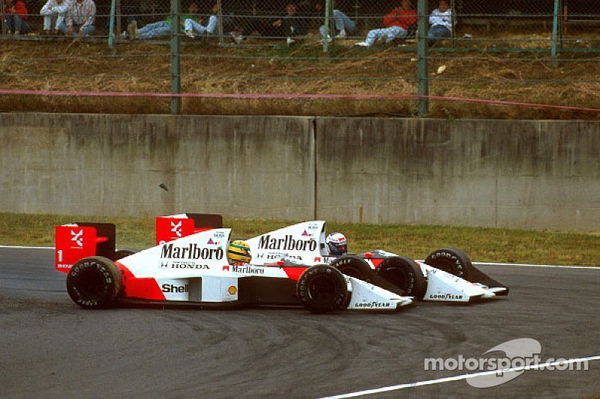
via Imago
Senna and Prost collided

via Imago
Senna and Prost collided
The year was 1989; the stage was set for another year of dominance by the McLaren-Hondas. The always exhilarating rivalry between Ayrton Senna and Alain Prost was set to be the theme of the season but Suzuka, Japan proved to be an anti-climactic event in the story of the Whose Championship Is It Anyway? Who would come out on top at the 1989 Japanese GP?
Prost was 16 points in the lead going into this race from Senna. Ayrton had to win both of the last two races (Suzuka, Australia) to be able to stay in contention or have any hope of retaining his Championship from ’88.
McLaren’s dominance was such that Prost sacrificed his qualifying setup because he knew even without the optimum setup he would always qualify on the front row of the grid. He opted for a much more efficient race setup as he knew the points are won on Sunday and not on the day before. That’s why he was “The Professor”.
ADVERTISEMENT
Article continues below this ad
Senna, on the other hand, knew he had to put pressure on Prost so he went all out on aggression and posted a qualifying lap, a whopping 1.7 seconds quicker than Prost and put his McLaren-Honda on pole for the 1989 Japanese GP.
As the lights went out on Sunday, the latter had a better start and swooped into the lead at the start of the race and with his optimized setup he was not going to look back. It was all down to Senna to take that place back.

Prost stretched out an 8 second lead from Senna, who started closing the gap once he had put on newer tires.
On lap 40, Senna finally caught Prost, and for the next five laps the gap between the two remained at approximately one second. The two McLaren drivers tried to position themselves tactically. Prost had greater top speed on the straights while Senna’s high-downforce settings gave him the advantage through the corners.
On lap 46 of the 1989 Japanese GP, Senna used his greater cornering speed to make sure that he remained close behind Prost’s car. Through the infamous 130R, ultra-high-speed, left curve, Senna cut Prost’s lead still further, putting his MP4/5 only two car lengths behind his rival.
130R leads to the one of the most prominent overtaking spots on the circuit, the Casino Triangle Chicane. For Senna knew it was now or never, he, with the high downforce setup and his “excellent on the brakes” driving style, dived down the inside from a long way back. Prost glimpsed the move in his mirrors and decided to block it. Neither of the drivers backed down. Push came to shove and they collided just before the apex of the corner, leaving both their cars stalled and damaged.
ADVERTISEMENT
Article continues below this ad
Prost climbed out immediately figuring Senna would do the same. But Senna requested the circuit marshals to put his car through the escape road such that he could restart his car. He got going again, got his car repaired and eventually crossed the finish line in first place.
Happy Ending, right? Well, the stewards had other ideas. They argued that because Senna used the escape road to rejoin the track, he didn’t complete the exact race distance and hence DISQUALIFIED him from the race results. This meant that Nannini won the 1989 Japanese GP and the championship to Prost.

via Imago
Senna and Prost collided
It was argued all over the world amongst fans, journalists, sports pundits over whose fault the crash was? Did Prost turn in early and take Senna out? Or did Senna attempt the move fairly considering he was too far back? We’ll never know. What we do know is that the FIA President at that time was Jean-Marie Balestre, a fellow French, like Prost. Whether he was involved in the decision, is something which is up for discussion. We also know that McLaren appealed this disqualification but leave out the result not being overturned and Senna was handed a US 100,000$ fine and labeled as “a dangerous driver”.
ADVERTISEMENT
Article continues below this ad
Prost eventually left McLaren and joined Ferrari for the 1990 season. Let us know what you think about the accident and the Grand Prix.
ADVERTISEMENT
ADVERTISEMENT
ADVERTISEMENT
ADVERTISEMENT

